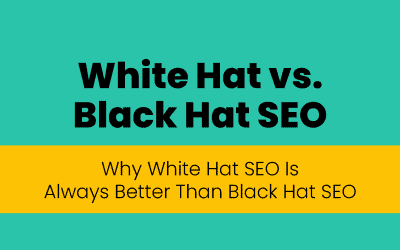Search engines are becoming increasingly complex as we step into the future. Many updates have been introduced this year alone, prompting website owners to think about what works now to rank well on search engines.
The key is to stay informed and updated with the changes. It is important to know which factors carry the most weight when it comes to ranking websites and optimizing your website accordingly. Bear in mind that there are ethical as well unethical ways to optimize your website for search engines.
While unethical ways can give you the results you want instantly, they are not worth it as they can have consequences in the long run. This is why it’s always advisable to use ethical SEO tactics or white hat SEO techniques to increase traffic, and you will soon realize why.
What is White Hat SEO?
White Hat SEO are SEO techniques that comply with the terms and conditions defined by search engines, such as Google. It’s the opposite of the much more risky black hat SEO, which tends to ignore the search engine rules and deploy shortcut SEO tactics to trick search engines into ranking the website well.
Therefore, the practice of improving your website’s rankings on search engine pages (SERPs) while observing the search engines’ terms of service and maintaining the integrity of your website is called white hat SEO. These are the safest SEO tactics that are sure to work both in the short run and in the long run.
Examples of some white hat SEO practices, are including valuable, high-quality content on your website, optimizing the platform for mobile devices, and fast loading times and offering a great user experience.
Black hat SEO, on the other hand, involves things such as deceptive cloaking methods or purchasing links. As Google algorithms become more and more intelligent, such tactics are tracked sooner or later. If these tactics are detected, your website can be banned from Google and other search engines, which will affect your ability to easily be found online.
This means, while you might be able to enjoy some benefits with black hat SEO in the beginning, these techniques are extremely risky and can suddenly backfire — and in a big way! Once you’re banned by Google, you may never be able to rank at all, resulting in disastrous consequences for your online presence.
Because of this, you should only consider Google-approved or white hat SEO techniques to increase traffic.
Following white hat SEO tactics will help boost your web traffic as well as retain it in the future!
Top White Hat SEO Techniques to Increase Traffic
1.) Link Building
Backlinks have been among the primary indicators for Google in deciding how to rank websites. By 2016, backlinks had a 30% influence on Google’s website-ranking process, as shown in the diagram below:
If you ignore this key ranking factor, you’ll really do yourself a disservice. The more high-quality backlinks your website has, the higher you will rank on Google. The key, however, is to use the right kind of links—links that are highly relevant to your website and belong to high-authority and high-ranking websites.
To obtain such links, you can include your website name on third-party directories, pitch other publications, use guest blogging, write testimonials, create valuable, share-worthy content, and establish mutual partnerships to obtain backlinks.
For consistent link building, you need to choose your partners carefully, engage in email outreach and make pitches while managing the velocity at which you acquire new links to your site. The process takes time, but it guarantees sustainable results.
2.) Keyword Research
One of the most powerful tools in the world of SEO is keyword research. The aim of keyword research is to find out which words your target audience is searching for on Google and rank for them on search engines.
When you are using keywords in your content, avoid keyword stuffing, a common black hat SEO tactic that’s not only annoying for site visitors but also ineffective for SEO. When you force keywords unnecessarily into the content, it hurts the readability and value of the content.
Keep in mind that Google wants websites to rank based on the quality of the content they produce, not based on the number of times they have used a specific word. It can easily catch the keyword stuffing practice and penalize you by lowering your rank on search engine pages (SERPs).
So what’s the white hat SEO approach for this? Start with finding the right keyword by using a Keyword tool such as keywordtool.io. Enter related terms and the tool will come up with a list of suggested keywords with search volumes for each keyword.
Pick 2-3 best keywords and add them in your content in such a way that Google crawlers can track them and know what the webpages are talking about. As long as you choose the keywords carefully and do not stuff them, your website should rank well on search engines.
3.) Content Creation
The impact of high-quality content on SEO can be judged from the fact that around 82% of digital marketers who blog every day generate at least one customer through their content. According to the Search Engine Journal, content is one of the top two ranking factors on Google.
To increase traffic, you need to engage in honest and helpful blogging to generate content that genuinely hits the pain points of your target audience and solves their problems. Once you’ve created great, useful content, you need to find the right audience and look for ways to reach them.
Empathize with your potential customers and keep your content as conversational as possible. Your aim should be to make it to Google’s rich answer box — a novel feature that provides users with a direct answer to search queries right at the top of the search results (that’s rank 0 or the result preceding rank 1). When a user enters a search query in the search bar, Google scans the web to find the closest answer to the question, presenting it in the rich answer box at the top.
To make it to the rich box, you need to use simple, conversational phrases and sentences to deliver insightful content so that Google can easily find answers in it to address search queries. Since most direct answers are given to questions that include ‘what, why, when, where, who, and how’ words, include these words, too.
For instance, if your content is about content marketing, you should certainly include a heading that says ‘What is Content Marketing?’ followed by a comprehensive answer for it.
This strategy should also help you target people that use voice search, the fastest growing search type these days. According to a mobile voice study by Google, 55% of teens and 41% of adults use voice search more than once a day. Voice search users are more likely to use terms like what, why, who, etc., than those who type queries in the search bar. Therefore, the above-mentioned content strategy should work best for targeting these growing users.
A high-ranking content piece, perhaps on the first page of Google search results, typically has 2000 to 2400 words, on average. The graph below shows how webpages are ranked based on their word count:
What really matters other than the content itself is how consistent you are with your blogging. Even if you don’t create long-form blog posts, be consistent with posting insightful content for your target audience and keep updating the content you’ve posted in the past with last industry changes and trends.
4.) Use a Relevant Brand Name
Many website owners create a brand name based on how cool it sounds. Choosing a relevant brand name can actually enhance your website’s SEO performance. However, you need to understand the difference between white hat and black hat SEO tactics when using this strategy.
Before we discuss white hat SEO techniques, let’s see how black hat SEOs choose a brand name. Black hat SEOs carry out keyword research, choose the most popular keyword, such as ‘best mobile seller’, and use that exact phrase as their brand name.
When a user searches that term, Google doesn’t exactly know whether the user is searching for a specific business or wants to explore top mobile sellers, so it shows all results. Thus, this black hat SEO tactic gets a shady advantage.
While Google hasn’t administered punishments for this practice, you never know what will happen in the future because Google’s main goal is to understand search intent and address it in the best way possible. It will keep eliminating tactics that mess that up.
A white hat SEO version of this technique, however, does exist. The idea remains the same, but you play a little safer. Type ‘content marketing’ on Google and see what turns up:
Just because the search query is considerably similar to the domain of this result, the Content Marketing Institute makes it to the top of the page.
While it may not be possible for every business, if you can change your domain or brand name to a better or more relevant one, it can certainly boost your website’s SEO performance. However, the tactic will only continue to work as long as you keep posting remarkable content, build quality links, and use the right keywords.
5.) Make Your Website Mobile-Friendly
If you don’t already know, Google index is going mobile-first. This means that if the content on your webpage is not easily accessible to a user from their mobile device, the page may not rank.
In other words, you can take a hit on search engine pages (SERPs) if your webpages aren’t mobile-friendly. Obtain the Mobile Usability Report from your Search Console account and take action to eliminate the mobile issues it reports.
One great solution is to use Accelerated Mobile Pages (AMP), an open-source initiative relying on AMP HTML to ensure instant loading on mobile devices.
6.) Internal Linking
Internal linking is the simple practice of linking one webpage to another within your website. The goal is to make it easier for Google to understand what your website content is about. Hence, internal linking has to make sense. For that, you need to organize the content topics based on what’s being discussed on each webpage.
A solid white hat SEO tactic is to use a pillar page, which serves as an in-depth resource for a particular topic. Let’s take a look at an example to help explain this better. Suppose you own a business and wish to share a lot of valuable information about brand awareness. You create content about the basics of brand awareness, how to kick-start your brand awareness, how to track your brand awareness, and so on.
Once you’ve posted the blogs on your webpage, create a pillar page that discusses brand awareness holistically. This is exactly what Typeform did, as you can see its pillar page in the screenshot below:
Your pillar page serves a massive resource that links out to blog posts on your website. The pillar page will link to all content under it and all that content will link back to the pillar page.
However, if you go overboard with internal linking, your webpages will appear like a Wikipedia page with too many links. Inserting too many internal links is a black hat SEO tactic, which can rather hurt your SEO performance. Consider including not more than 2 to 3 internal links in each blog post. Then, use pillar pages to organize the content, linking to multiple landing pages.
Final Word
Now that you have a strong grip over white hat SEO techniques, you no longer need to follow black hat SEO tactics that your friends have been recommending.
Remember that Google uses RankBrain, a machine-learning AI algorithm, to search the search results. This algorithm keeps on learning and becoming smarter, which is why it’s second name is machine learning. So no matter how well black hat SEO tactics worked for you up till now, they will eventually be tracked by Google and ruin your chances of being successful. Hence, it’s time you switch to using white hat SEO techniques to increase traffic. Following the above-explained tactics will help boost your web traffic as well as retain it in the future!
- A Step-By-Step Guide to Designing a Mobile-Friendly Website - November 11, 2024
- How Content Marketing Enhances Your Website’s SEO Performance - November 11, 2024
- How to Pick the Perfect Color Scheme for Your Website Design - November 11, 2024









